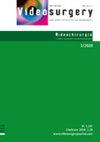Lymphovascular invasion predicts disease-specific survival in node-negative esophageal squamous cell carcinoma patients after minimally invasive esophagectomy
IF 1.6
4区 医学
Q2 SURGERY
引用次数: 1
Abstract
Introduction Lymphovascular invasion (LVI) is reported to be a potential prognostic predictor in esophageal squamous cell carcinoma (ESCC) patients. Aim To investigate the prognostic value of LVI in ESCC node-negative patients after minimally invasive esophagectomy (MIE). Material and methods 1406 consecutive ESCC patients who underwent MIE were reviewed retrospectively. After exclusion, 880 patients were enrolled, and 298 node-negative patients were used for the further analysis. The Kaplan-Meier method was used to examine the survival difference. Univariate and multivariate analyses were performed to identify prognostic predictors. Results LVI was observed in 29.4% of all patients. Totally, the proportion of LVI was increased with advanced T (p < 0.01) and N (p < 0.01) stage and poor tumor differentiation (p < 0.01). In the node-negative patients, a similar result was obtained in T stage (p = 0.0252) and tumor differentiation (p = 0.0080). In survival analysis, the disease-specific survival (DSS) (p = 0.0146) rate was significantly lower in node-negative patients with LVI than in those without. The difference was absent when calculating disease-free survival (DFS) (p = 0.0796). Additionally, the presence of LVI was associated with lower DSS (p = 0.0187) but not DFS (p = 0.0785) in univariate analysis in node-negative patients. Moreover, in multivariate Cox regression analysis, the presence of LVI was identified as an independent prognostic factor only in DSS (p = 0.0496) but not in DFS (p = 0.5670) in node-negative patients. Conclusions LVI is associated with shorter DSS and an independent prognostic factor in ESCC node-negative patients after MIE.淋巴血管侵袭预测微创食管切除术后淋巴结阴性食管鳞状细胞癌患者的疾病特异性生存率
引言淋巴血管侵犯(LVI)被报道为食管鳞状细胞癌(ESCC)患者的潜在预后预测指标。目的探讨LVI对微创食管切除术(MIE)后ESCC淋巴结阴性患者的预后价值。材料和方法回顾性分析1406例连续接受MIE的ESCC患者。排除后,880名患者被纳入,298名淋巴结阴性患者被用于进一步分析。采用Kaplan-Meier法检测生存率差异。进行单变量和多变量分析以确定预后预测因素。结果LVI发生率为29.4%。总的来说,LVI的比例随着晚期T(p<0.01)和N(p<0.01)分期以及肿瘤分化不良(p<0.01)而增加。在淋巴结阴性患者中,T分期(p=0.0252)和肿瘤分化(p=0.0080)的结果相似。在生存分析中,有LVI的淋巴结阴性患者的疾病特异性生存率(DSS)(p=0.0146)显著低于无LVI的患者。在计算无病生存期(DFS)时没有差异(p=0.0796)。此外,在淋巴结阴性患者的单变量分析中,LVI的存在与较低的DSS相关(p=0.0187),但与DFS无关(p=0.0785)。此外,在多变量Cox回归分析中,LVI的存在仅在DSS中被确定为一个独立的预后因素(p=0.0496),而在淋巴结阴性患者的DFS中则没有(p=0.5670)。结论LVI与MIE后ESCC结阴性患者较短的DSS和一个独立的预后因素有关。
本文章由计算机程序翻译,如有差异,请以英文原文为准。
求助全文
约1分钟内获得全文
求助全文
来源期刊
CiteScore
2.80
自引率
23.50%
发文量
48
审稿时长
12 weeks
期刊介绍:
Videosurgery and other miniinvasive techniques serves as a forum for exchange of multidisciplinary experiences in fields such as: surgery, gynaecology, urology, gastroenterology, neurosurgery, ENT surgery, cardiac surgery, anaesthesiology and radiology, as well as other branches of medicine dealing with miniinvasive techniques.

 求助内容:
求助内容: 应助结果提醒方式:
应助结果提醒方式:


